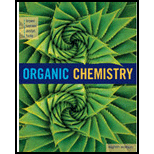
Interpretation:
Synthetic intermediates A and B have to be drawn.
Concept Introduction:
Conversion of alcohol into
Conversion of primary and secondary alcohols to Chloroalkane is thionyl chloride. The reaction is carried out in the presence of base such as pyridine or trimethylamine.
The reaction of an alcohol with thionyl chloride is the formation of an alkyl Chlorosulfite that converts hydroxide ion (poor leaving group) into Chlorosulfite (good leaving group). Nucleophilic displacement of this leaving group gives product.
Leaving group: Leaving group can be any groups or atoms that get detached from either neutral or charged organic compounds. The stability of the leaving group is to stabilize the electron density that results from heterolysis cleavage of bond.
Trending nowThis is a popular solution!

Chapter 10 Solutions
ORGANIC CHEMISTRY-OWL V2 ACCESS
- Draw the structural formula of the products formed when each alkene is treated with one equivalent of NBS in CH2Cl2 in the presence of light.arrow_forwardBoth 1,2-dihydronaphthalene and 1,4-dihydronaphthalene may be selectively hydrogenated to 1,2,3,4-tetrahydronaphthalene.One of these isomers has a heat of hydrogenation of 101 kJ/mol (24.1 kcal/mol), and the heat of hydrogenation of the other is 113 kJ/mol (27.1 kcal/mol). Match the heat of hydrogenation with the appropriate dihydronaphthalene.arrow_forwardSN2 reaction is an example of a nucleophilic substitution reaction. Imagine that 1-iodobutane reacts with 4-methylheptan-1-ol under basic conditions. Draw the structure of the two reactants.arrow_forward
- Use a sheet of paper to answer the following question. Take a picture of your answers and attach to this assignment. n-Pentanol (CH3CH2CH₂CH₂CH₂OH) and 2-methylbutan-2-ol (CH3CH₂C(CH3)2OH) are converted to their corresponding alkyl chorides on being reacted with hydrogen chloride. (a) Write out an equation for each reaction (b) Assign each the appropriate symbol (SN1 or SN2) (c) Write a suitable mechanism for each reactionarrow_forwardDuring an experiment in your chemistry lab, your instructor assigned your group to make a refill of Fehling’s A and Fehling’s B solution and Benedicts solution. Both Fehling’s and Benedict’s solutions are a reagent used to differentiate aldehydes from ketones and used for detecting reducing sugars. Your group was asked to make 120 ml of each solution. Show your complete solution. Preparation of Fehling's solution A:Dissolve 35g of Cu2SO4.7H2O in water and make up to 500mlPreparation of Fehling's solution B:Dissolve 120 g of KOH and 173 g of Sodium Potassium Tartrate (Rochelle salt) in water and make up to 500 mlarrow_forward1. The acid-catalyzed elimination of an alcohol is an equilibrium reaction and requires special reac- tion conditions to favour the formation of the alkene product. What chemical principle controls the amount of alkene product that is produced? Provide two laboratory techniques that can be used to obtain good alkene yields in alcohol elimination reactions.arrow_forward
- In the chemical synthesis of DNA and RNA, hydroxyl groups are normally converted to triphenylmethyl (trityl) ethers to protect the hydroxyl group from reaction with other reagents. Triphenylmethyl ethers are stable to aqueous base but are rapidly cleaved in aqueous acid. (a) Why are triphenylmethyl ethers so readily hydrolyzed by aqueous acid? (b) How might the structure of the triphenylmethyl group be modified to increase or decrease its acid sensitivity?arrow_forwardWhat products would result from the following processes? Write an equation for each reaction. a. 2-Methyl-2-butanol is subjected to controlled oxidation. b. 1-Propanol is heated to 140C in the presence of sulfuric acid. c. 3-Pentanol is subjected to controlled oxidation. d. 3-Pentanol is heated to 180C in the presence of sulfuric acid. e. 1-Hexanol is subjected to an excess of oxidizing agent.arrow_forwardAccount for the fact that treating propenoic acid (acrylic acid) with HCl gives only 3-chloropropanoic acid.arrow_forward
- 16-54 Several poisonous plants, including Atropa belladonna, contain the alkaloid atropine. The name “belladonna” (which means “beautiful lady”) probably comes from the fact that Roman women used extracts from this plant to make themselves more attractive. Atropine is widely used by ophthal mologists and optometrists to dilate the pupils for eye examination. Classify the amino group in atropine as primary, secondary, or tertiary. Locate all stereocenters in atropine. Account for the fact that atropine is almost insoluble in water (1 g in 455 mL of cold water) but atropine hydrogen sulfate is very soluble (1 g in 5 mL of cold water). Account for the fact that a dilute aqueous solution of atropine is basic (pH approximately 10.0).arrow_forwardGive IUPAC names for the following substances:arrow_forwardIdentify the most important aldehyde and ketone from Section 14.4 on the basis of amount used, and list at least one characteristic for each that contributes to its usefulness.arrow_forward
 Organic ChemistryChemistryISBN:9781305580350Author:William H. Brown, Brent L. Iverson, Eric Anslyn, Christopher S. FootePublisher:Cengage Learning
Organic ChemistryChemistryISBN:9781305580350Author:William H. Brown, Brent L. Iverson, Eric Anslyn, Christopher S. FootePublisher:Cengage Learning Introduction to General, Organic and BiochemistryChemistryISBN:9781285869759Author:Frederick A. Bettelheim, William H. Brown, Mary K. Campbell, Shawn O. Farrell, Omar TorresPublisher:Cengage Learning
Introduction to General, Organic and BiochemistryChemistryISBN:9781285869759Author:Frederick A. Bettelheim, William H. Brown, Mary K. Campbell, Shawn O. Farrell, Omar TorresPublisher:Cengage Learning Chemistry for Today: General, Organic, and Bioche...ChemistryISBN:9781305960060Author:Spencer L. Seager, Michael R. Slabaugh, Maren S. HansenPublisher:Cengage Learning
Chemistry for Today: General, Organic, and Bioche...ChemistryISBN:9781305960060Author:Spencer L. Seager, Michael R. Slabaugh, Maren S. HansenPublisher:Cengage Learning Organic And Biological ChemistryChemistryISBN:9781305081079Author:STOKER, H. Stephen (howard Stephen)Publisher:Cengage Learning,
Organic And Biological ChemistryChemistryISBN:9781305081079Author:STOKER, H. Stephen (howard Stephen)Publisher:Cengage Learning, General, Organic, and Biological ChemistryChemistryISBN:9781285853918Author:H. Stephen StokerPublisher:Cengage Learning
General, Organic, and Biological ChemistryChemistryISBN:9781285853918Author:H. Stephen StokerPublisher:Cengage Learning Organic Chemistry: A Guided InquiryChemistryISBN:9780618974122Author:Andrei StraumanisPublisher:Cengage Learning
Organic Chemistry: A Guided InquiryChemistryISBN:9780618974122Author:Andrei StraumanisPublisher:Cengage Learning





